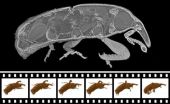(Press-News.org) While many overweight patients have the best intentions to lose weight after joint replacement, a study at Hospital for Special Surgery (HSS) finds that although some are able to achieve this goal, equal numbers of patients actually gain weight after hip or knee replacement. Researchers also determined that patients who lose weight do better in terms of function and activity level two years down the road.
"Our findings represent the first report to present evidence that weight loss is associated with improved clinical outcomes, while weight gain is associated with inferior outcomes, although these results are really not surprising," said Geoffrey Westrich, MD, senior investigator and director of research, Adult Reconstruction and Joint Replacement at Hospital for Special Surgery.
More than one million knee and hip replacements are performed in the United States each year, according to the Centers for Disease Control and Prevention. (Knee = 719,000; Hip = 332,000).
Following almost 7,000 patients enrolled in the joint replacement registry at HSS, researchers found that while some patients lost or gained weight after joint replacement, the majority of patients maintained the same body mass index, or BMI, that they had prior to surgery.
The paper, titled, "Weight Change after Hip and Knee Arthroplasty: Incidence, Predictors and Effects on Clinical Outcomes," will be presented at the annual meeting of the American Academy of Orthopaedic Surgeons in New Orleans on March 14.
"Previous studies provided conflicting evidence regarding whether patients lose or gain weight after lower extremity joint replacement," Dr. Westrich said. "And prior to our study, there was little research examining whether weight change after joint replacement was associated with a difference in clinical outcomes. We aimed to answer these questions, and also see if there are factors that predispose patients to gain or lose weight after surgery."
Using the HSS joint replacement registry, researchers examined the two-year change in body mass indices (BMI) for all patients undergoing elective hip or knee replacement surgery to relieve osteoarthritis.
A total of 3,036 knee and 3,893 hip replacement surgeries were reviewed. Findings:
Seventy-four percent of total knee replacement patients and 84 percent of total hip replacement patients did not demonstrate a change in BMI following surgery.
Patients who underwent knee replacement were more likely to lose weight after surgery than those undergoing hip replacement.
Patients who were obese prior to joint replacement were more likely to lose weight than those who were of normal weight or overweight, but not obese.
Overweight or obese females undergoing joint replacement were more likely to lose weight than their male or normal weight counterparts.
Patients with higher preoperative activity scores were more likely to maintain their weight than to gain or lose weight.
Researchers considered a number of other factors to see if they were associated with a change in weight. These factors included patient scores on preoperative surveys to assess pain, stiffness, and physical function; whether the patient was discharged to home or a rehabilitation facility; whether or not the patient smoked; and co-existing health problems such as diabetes, hypertension and depression. None of these factors was determined to predispose patients to experiencing weight gain or loss after joint replacement.
When comparing clinical outcomes, investigators looked at Physical Component Scores (PCS), which consider such factors as pain and functioning, and Lower Extremity Activity Scores (LEAS), which assess activity levels.
Knee replacement patients who lost weight following surgery demonstrated significantly better scores when compared to those who maintained or gained weight after surgery.
Weight gain was associated with inferior PCS and LEAS scores for both hip and knee replacement patients.
"Based on our findings, as physicians, we should convey to our patients the importance of maintaining good health and an appropriate weight, and we should help them in any way we can to achieve this goal," Dr. Westrich said.
INFORMATION:
Paper Title: Weight Change after Hip and Knee Arthroplasty: Incidence, Predictors and Effects on Clinical Outcomes
Authors: Michael P. Ast, MD, New York, New York
Matthew P. Abdel, MD, Eagan, Minnesota
Alexandra Gorab, BS, New York, New York
Yuo-Yu Lee, MS, New York, New York
Allison Ruel, BA, New York, New York
Stephen Lyman, PhD, New York, New York
Geoffrey H. Westrich, MD, New York, New York
About Hospital for Special Surgery
Founded in 1863, Hospital for Special Surgery (HSS) is a world leader in orthopedics, rheumatology and rehabilitation. HSS is nationally ranked No. 1 in orthopedics, No. 4 in rheumatology, and No. 5 in geriatrics by U.S.News & World Report (2013-14), and is the first hospital in New York State to receive Magnet Recognition for Excellence in Nursing Service from the American Nurses Credentialing Center three consecutive times. HSS has one of the lowest infection rates in the country. From 2007 to 2012, HSS has been a recipient of the HealthGrades Joint Replacement Excellence Award. HSS is a member of the NewYork-Presbyterian Healthcare System and an affiliate of Weill Cornell Medical College and as such all Hospital for Special Surgery medical staff are faculty of Weill Cornell. The hospital's research division is internationally recognized as a leader in the investigation of musculoskeletal and autoimmune diseases. Hospital for Special Surgery is located in New York City and online at http://www.hss.edu.
Study: Losing or gaining weight after joint replacement affects how well patients do
In largest study to date, Hospital for Special Surgery researchers find that patients who lose weight have better joint replacement outcomes
2014-03-14
ELSE PRESS RELEASES FROM THIS DATE:
Southeastern fires consist of prescribed and wild
2014-03-14
According to the Southern Area Coordination Center, which monitors and coordinates response to incidents throughout the Southeast, there are currently seven large fires burning in this area of the country. Six of them are located in the state of Oklahoma and the seventh is in the Gulf area of Louisiana. These fires currently have burned over 7,600 acres. The majority of the fires on this image, though, are not wildfires, but are prescribed fires. The Chicasaw Journal of Mississippi wrote this regarding prescribed fires: "Prescribed fire, also known as controlled burning, ...
Researchers find significant increase in painkillers prescribed to US adults in the ER
2014-03-14
WASHINGTON (March 14, 2014) —George Washington University (GW) researchers report dramatic increases in prescriptions of opioid analgesics, such as Percocet, Vicodin, oxycodone and Dilaudid, during U.S. emergency department visits from 2001 to 2010. These findings were not explained by higher visit rates for painful conditions, which only increased modestly during the time period. This report was published today in the journal Academic Emergency Medicine.
"This trend is especially concerning given dramatic increases in opioid-related overdoses and fatalities in recent ...
In the lab, scientists coax E. coli to resist radiation damage
2014-03-14
MADISON, Wis. – Capitalizing on the ability of an organism to evolve in response to punishment from a hostile environment, scientists have coaxed the model bacterium Escherichia coli to dramatically resist ionizing radiation and, in the process, reveal the genetic mechanisms that make the feat possible.
The study, published in the online journal eLife, provides evidence that just a handful of genetic mutations give E. coli the capacity to withstand doses of radiation that would otherwise doom the microbe. The findings are important because they have implications for better ...
Researchers find high acceptability of 3-colored raspberry jelly
2014-03-14
CHICAGO—Raspberries are among the most popular berries in the world and are high in antioxidants that offer significant health benefits to consumers. The red raspberry is most commonly used in processed products like juices, jams, jellies and preserves because of its short shelf life. A new study in the Journal of Food Science, published by the Institute of Food Technologists (IFT), found that the production of a mixed raspberry jelly with black and yellow raspberries could be a good alternative to just one-colored jelly.
Black raspberries, which produce clusters of ...
Gluten-free crackers made with hemp flour and decaffeinated green tea leaves
2014-03-14
CHICAGO—The market for gluten-free foods with functional properties is growing immensely across virtually all food categories on a global level. The need to replace wheat proteins, fibers, and minerals is very important in order to provide a better selection and more nutritious food for consumers that belong to this segment of the population. At the same time, the use of by-products of the food processing industry as a source of functional ingredients such as antioxidants, phenols, fibers and proteins is on the rise, which supports global sustainability.
A team of food ...
Genes may thwart seniors' exercise gains
2014-03-14
Bethesda, Md. (March 14, 2014)—Keeping strong and physically fit is crucial to maintaining independence among the elderly. Exercise has repeatedly been shown to reduce or slow age-related declines in physical function and is a widely recommended for seniors, but the way that older people respond to exercise varies widely. A new study by Thomas W. Buford et al. examines the ACE I/D gene and whether its variations—the ID, DD, and II genotypes—impact some seniors' ability to fully reap the benefits of exercise.
Researchers followed 424 sedentary, mobility-limited seniors ...
Brighter inks, without pigment
2014-03-14
Cambridge, Mass. – March 14, 2014 – Among the taxidermal specimens in Harvard's Museum of Comparative Zoology, past centuries-old fur coats, arises a flicker of brilliant blue. This is the spangled cotinga. Surprisingly, the cotinga is about as old as everything in the room, but its color is still as dazzling as the day it was brought to the museum. The cotinga—or rather its feathers—achieve this effect through structural color.
Unlike color that we usually think of, which arises from paints and dyes absorbing certain wavelengths of light and reflecting the remainder, ...
Patients should wait 6 to 12 weeks before driving after shoulder surgery
2014-03-14
NEW ORLEANS--More than 53,000 Americans have total shoulder joint replacement (SJR) surgery each year, and yet the effects of this surgery on a patient's ability to safely drive a vehicle, and the appropriate recovery time before patients should return to driving, have yet to be determined. In a new study, "Driving Performance after Total Shoulder Arthroplasty," presented today at the 2014 Annual Meeting of the American Academy of Orthopaedic Surgeons (AAOS), the driving skills of 28 shoulder replacement patients, with a mean age of 65 ±10 years, were tested at four distinct ...
3-D X-ray film: Rapid movements in real time
2014-03-14
This news release is available in German. How does the hip joint of a crawling weevil move? A technique to record 3D X-ray films showing the internal movement dynamics in a spatially precise manner and, at the same time, in the temporal dimension has now been developed by researchers at ANKA, KIT's Synchrotron Radiation Source. The scientists applied this technique to a living weevil. From up to 100,000 two-dimensional radiographs per second, they generated complete 3D film sequences in real time or slow motion. The results are now published in the Proceedings of the ...
Patient requests for specific drugs have major impact on prescribing, reports study in Medical Care
2014-03-14
Philadelphia, Pa. (March 14, 2014) – Patient requests for specific medications—including requests for brand-name drugs spurred by direct-to-consumer (DTC) advertising—have a substantial impact on doctors' prescribing decisions, suggests a study in the April issue of Medical Care. The journal is published by Lippincott Williams & Wilkins, a part of Wolters Kluwer Health.
"A patient request for a specific medication dramatically increases the rate at which physician s prescribe that medication," according to the new research led by John B. McKinlay, PhD, of New England ...
LAST 30 PRESS RELEASES:
First ‘Bible map’ published 500 years ago still influences how we think about borders
Why metabolism matters in Fanconi anemia
Caribbean rainfall driven by shifting long-term patterns in the Atlantic high-pressure system, study finds
Potential treatment to bypass resistance in deadly childhood cancer
RSV vaccines could offer protection against asthma
Group 13 elements: the lucky number for sustainable redox agents?
Africa’s forests have switched from absorbing to emitting carbon, new study finds
Scientists develop plastics that can break down, tackling pollution
What is that dog taking? CBD supplements could make dogs less aggressive over time, study finds
Reducing human effort in rating software
Robots that rethink: A SMU project on self-adaptive embodied AI
Collaborating for improved governance
The 'black box' of nursing talent’s ebb and flow
Leading global tax research from Singapore: The strategic partnership between SMU and the Tax Academy of Singapore
SMU and South Korea to create seminal AI deepfake detection tool
Strengthening international scientific collaboration: Diamond to host SESAME delegation from Jordan
Air pollution may reduce health benefits of exercise
Ancient DNA reveals a North African origin and late dispersal of domestic cats
Inhibiting a master regulator of aging regenerates joint cartilage in mice
Metronome-trained monkeys can tap to the beat of human music
Platform-independent experiment shows tweaking X’s feed can alter political attitudes
Satellite data reveal the seasonal dynamics and vulnerabilities of Earth’s glaciers
Social media research tool can lower political temperature. It could also lead to more user control over algorithms.
Bird flu viruses are resistant to fever, making them a major threat to humans
Study: New protocol for Treg expansion uses targeted immunotherapy to reduce transplant complications
Psychology: Instagram users overestimate social media addiction
Climate change: Major droughts linked to ancient Indus Valley Civilization’s collapse
Hematological and biochemical serum markers in breast cancer: Diagnostic, therapeutic, and prognostic significance
Towards integrated data model for next-generation bridge maintenance
Pusan National University researchers identify potential new second-line option for advanced biliary tract cancer
[Press-News.org] Study: Losing or gaining weight after joint replacement affects how well patients doIn largest study to date, Hospital for Special Surgery researchers find that patients who lose weight have better joint replacement outcomes


